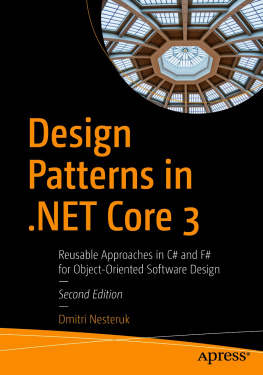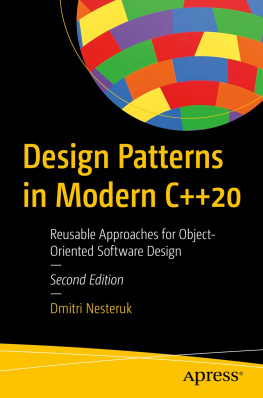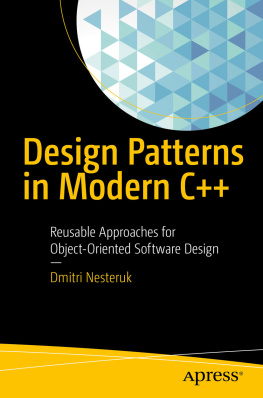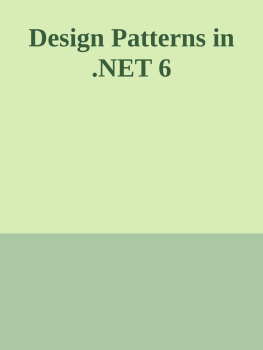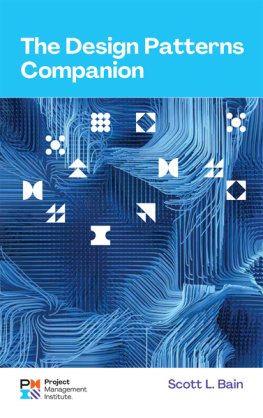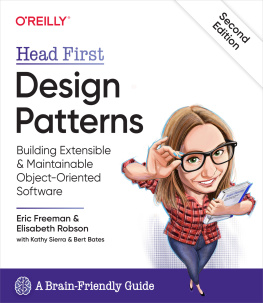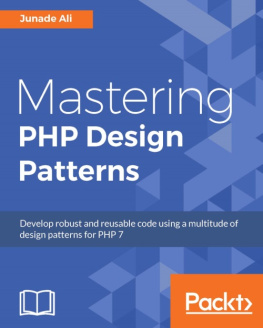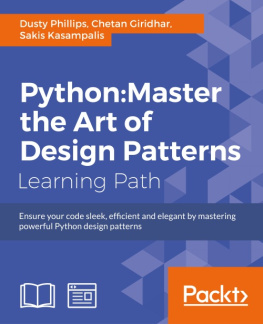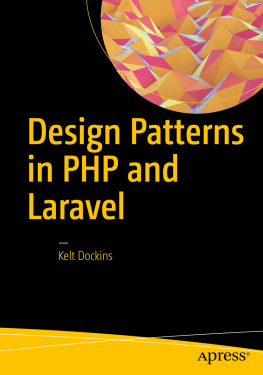Dmitri Nesteruk - Design Patterns in C#
Here you can read online Dmitri Nesteruk - Design Patterns in C# full text of the book (entire story) in english for free. Download pdf and epub, get meaning, cover and reviews about this ebook. year: 2018, publisher: leanpub.com, genre: Computer. Description of the work, (preface) as well as reviews are available. Best literature library LitArk.com created for fans of good reading and offers a wide selection of genres:
Romance novel
Science fiction
Adventure
Detective
Science
History
Home and family
Prose
Art
Politics
Computer
Non-fiction
Religion
Business
Children
Humor
Choose a favorite category and find really read worthwhile books. Enjoy immersion in the world of imagination, feel the emotions of the characters or learn something new for yourself, make an fascinating discovery.

- Book:Design Patterns in C#
- Author:
- Publisher:leanpub.com
- Genre:
- Year:2018
- Rating:3 / 5
- Favourites:Add to favourites
- Your mark:
- 60
- 1
- 2
- 3
- 4
- 5
Design Patterns in C#: summary, description and annotation
We offer to read an annotation, description, summary or preface (depends on what the author of the book "Design Patterns in C#" wrote himself). If you haven't found the necessary information about the book — write in the comments, we will try to find it.
Design Patterns in C# — read online for free the complete book (whole text) full work
Below is the text of the book, divided by pages. System saving the place of the last page read, allows you to conveniently read the book "Design Patterns in C#" online for free, without having to search again every time where you left off. Put a bookmark, and you can go to the page where you finished reading at any time.
Font size:
Interval:
Bookmark:

This book is for sale at http://leanpub.com/csharp_patterns
This version was published on 2020-05-13

* * * * *
This is a Leanpub book. Leanpub empowers authors and publishers with the Lean Publishing process. Lean Publishing is the act of publishing an in-progress ebook using lightweight tools and many iterations to get reader feedback, pivot until you have the right book and build traction once you do.
* * * * *
The topic of Design Patterns sounds dry, academically dull and, in all honesty, done to death in almost every programming language imaginable including programming languages such as JavaScript which arent even properly object-oriented programming (OOP)! So why another book on it? I know that if youre reading this, you probably have a limited amount of time to decide whether this book is worth the investment.
I decided to write this book to fill a gap left by the lack of in-depth patterns books in the .NET space. Plenty of books have been written over the years, but few have attempted to research all the ways in which modern C# and F# language features can be used to implement design patterns, and to present corresponding examples. Having just completed a similar body of work for C++, I thought it fitting to replicate the process with .NET.
Now, on to design patterns the original Design Patterns book was published with examples in C++ and Smalltalk and, since then, plenty of programming languages have incorporated certain design patterns directly into the language. For example, C# directly incorporated the Observer pattern with its built-in support for events (and the corresponding event keyword).
Design Patterns are also a fun investigation of how a problem can be solved in many different ways, with varying degrees of technical sophistication and different sorts of trade-offs. Some patterns are more or less essential and unavoidable, whereas other patterns are more of a scientific curiosity (but nevertheless will be discussed in this book, since Im a completionist).
Readers should be aware that comprehensive solutions to certain problems often result in overengineering, or the creation of structures and mechanisms that are far more complicated than is necessary for most typical scenarios. Although overengineering is a lot of fun (hey, you get to fully solve the problem and impress your co-workers), its often not feasible due to time/cost/complexity constraints.
This book is designed to be a modern-day update to the classic GoF book, targeting specifically the C# and F# programming languages. My focus is primarily on C# and the object-oriented paradigm, but I thought it fair to extend the book in order to cover some aspects of functional programming and the F# programming language.
The goal of this book is to investigate how we can apply the latest versions of C# and F# to the implementation of classic design patterns. At the same time, its also an attempt to flesh out any new patterns and approaches that could be useful to .NET developers.
Finally, in some places, this book is quite simply a technology demo for C# and F#, showcasing how some of the latest features (e.g., default interface methods) make difficult problems a lot easier to solve.
The examples in this book are all suitable for putting into production, but a few simplifications have been made in order to aid readability:
- I use public fields. This is not a coding recommendation, but rather an attempt to save you time. In the real world, more thought should be given to proper encapsulation and, in most cases, you probably want to use properties instead.
- I often allow too much mutability either by not using
readonlyor by exposing structures in such a way that their modification can cause threading concerns. We cover concurrency issues for a few select patterns, but I havent focussed on each one individually. - I dont do any sort of parameter validation or exception handling, again to save some space. Some very clever validation can be done using C# 8 pattern matching, but this doesnt have much to do with design patterns.
You should be aware that most of the examples leverage the latest version of C# and generally use the latest C# language features that are available to developers. For example, I use dynamic, pattern matching and expression-bodied members liberally.
At certain points in time, I will be referencing other programming languages such as C++ or Kotlin. Its sometimes interesting to note how designers of other languages have implemented a particular feature. C# is no stranger to borrowing generally available ideas from other languages, so I will mention those when we come to them.
As I write this book, the streets outside are almost empty. Shops are closed, cars are parked, public transport is rare and empty too. Life is almost at a standstill as the country endures its first non-working month, a curious occurence that one (hopefully) only encounters once in a lifetime. The reason for this is, of course, the COVID-19 pandemic that will go down in the history books. We use the phrase stop the world a lot when talking about the Garbage Collector, but this pandemic is a real stop the world event.
Of course, its not the first. In fact, theres a pattern there too: a virus emerges, we pay little heed until its spreading around the globe. Its exact nature is different in time, but the mechanisms for dealing with it remain the same: we try to stop it from spreading and look for a cure. Only this time round it seems to have really caught us off-guard and now the whole world is suffering.
Whats the moral of the story? Pattern recognition is critical for our survival. Just as the hunters and gatherers needed to recognize predators from prey and distinguish between edible and poisonous plants, so we learn to recognize common engineering problems good and bad and try to be ready for when the need arises.
SOLID is an acronym which stands for the following design principles (and their abbreviations):
- Single Responsibility Principle (SRP)
- Open-Closed Principle (OCP)
- Liskov Substitution Principle (LSP)
- Interface Segregation Principle (ISP)
- Dependency Inversion Principle (DIP)
These principles were introduced by Robert C. Martin in the early 2000s in fact, they are just a selection of 5 principles out of dozens that are expressed in Roberts books and his blog. These five particular topics permeate the discussion of patterns and software design in general, so before we dive into design patterns (I know youre all eager), were going to do a brief recap of what the SOLID principles are all about.
Suppose you decide to keep a journal of your most intimate thoughts. The journal has a title and a number of entries. You could model it as follows:
publicclassJournal{privatereadonlyList<string>entries=newList<Font size:
Interval:
Bookmark:
Similar books «Design Patterns in C#»
Look at similar books to Design Patterns in C#. We have selected literature similar in name and meaning in the hope of providing readers with more options to find new, interesting, not yet read works.
Discussion, reviews of the book Design Patterns in C# and just readers' own opinions. Leave your comments, write what you think about the work, its meaning or the main characters. Specify what exactly you liked and what you didn't like, and why you think so.

